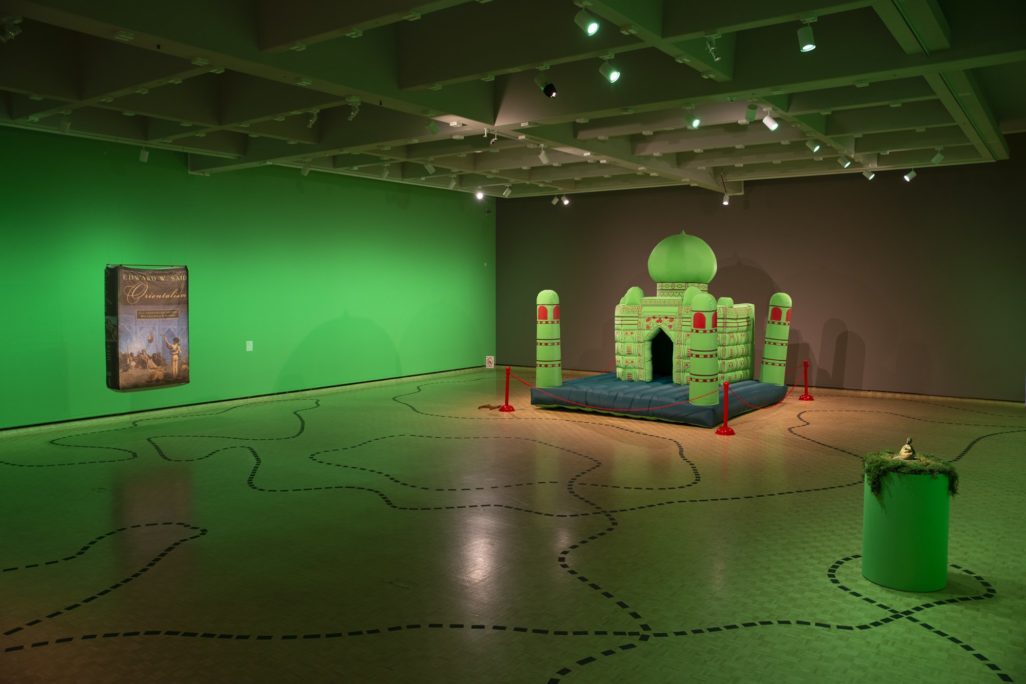Divya Mehra: From India to Canada and Back to India (There is nothing I can possess which you cannot take away)
7 August 2020 – 2 January 2021
About the Exhibition
Curated By
John G. Hampton
Organized By
The MacKenzie Art Gallery
Galleries
Kenderdine Gallery
From India to Canada and Back to India (There is nothing I can possess which you can not take away) features new and recent work by Divya Mehra that unravels the West’s obsession with simultaneously defining and consuming the histories and identities of other cultures. In this collection of reproduced, misclassified, staged, and stolen cultural property, Mehra deftly and playfully navigates complex networks of colonial entitlement, popular culture, art history, sacred objects, exotic adventurism, and novelty. Her work both entices and withholds, requiring the viewer to confront their own complicated relationships to the subject matter while also directly implicating the MacKenzie itself in the fraught colonial underpinnings of ownership and display in institutional collections.
Explore the work of Divya Mehra on CBC’s In the Making! Stream the episode now.
SUPPORTED BY

About the Artist
Known for her meticulous attention to the interaction of form, medium and site, Divya Mehra’s work deals with her diasporic experiences and historical narratives. She incorporates found artifacts and readymade objects as active signifiers of resistance or as reminders of the difficult realities of displacement, loss, neutrality and oppression. Mehra works in a multitude of forms, including sculpture, print, drawing, artist books, installation, advertising, performance, video and film. She holds an MFA from Columbia University and is represented by Georgia Scherman Projects.
Commentary
Works in the Exhibition

Divya Mehra, The World Isn’t a Fair Place: Just Barely Adrift on your perceived Cultural Landscape (The Browning of America and the Color of Crime), 2018, inflatable polyester book. Photo by Sarah Fuller. Image courtesy the artist and Georgia Scherman Projects.

Divya Mehra, There is nothing you can possess which I cannot take away (Not Vishnu: New ways of Darsána), 2020, coffee, sand, chamois leather, leather cord, metal grommets, 2.4 lbs. Photo by Sarah Fuller. Image courtesy the artist and Georgia Scherman Projects.

Divya Mehra, Magic rocks. Fortune and glory., 2020, dotted line for treasure map, dimensions variable. Photo by Sarah Fuller. Image courtesy the artist and Georgia Scherman Projects.

Divya Mehra, Afterlife of Colonialism, a reimagining of Power: It’s possible that the Sun has set on your Empire OR Why your voice does not matter: Portrait of an Imbalanced, and yet contemporary diasporic India vis-à-vis Colonial Red, Curry Sauce Yellow, and Paradise Green, placed neatly beneath these revived medieval forms: The Challenges of entering a predominately White space (Can you get this in the gift shop?) where all Women and Magical Elephants may know this work, here in your Winnipeg, among all my Peers, desiring to be both seen and see the loot through this Jungle Vine camouflage, 2020, inflatable attempt at the Taj Mahal, acrylic deep base paint, 15’ x 15’ x 15’.

Norman MacKenzie, Idols: Hindustan, Thibet, Buhrma, China, Congo, c. 1920 - 1936. MacKenzie Art Gallery Reference Collection. Photo by Sarah Fuller. Image courtesy the artist and Georgia Scherman Projects.
Events
-
![]()
Special Programming
Annapoorna Repatriation Farewell
12 December 2020
-
![]()
Special Programming
Yield Your Time: A Group Reaction Zoom Event
29 October 2020



